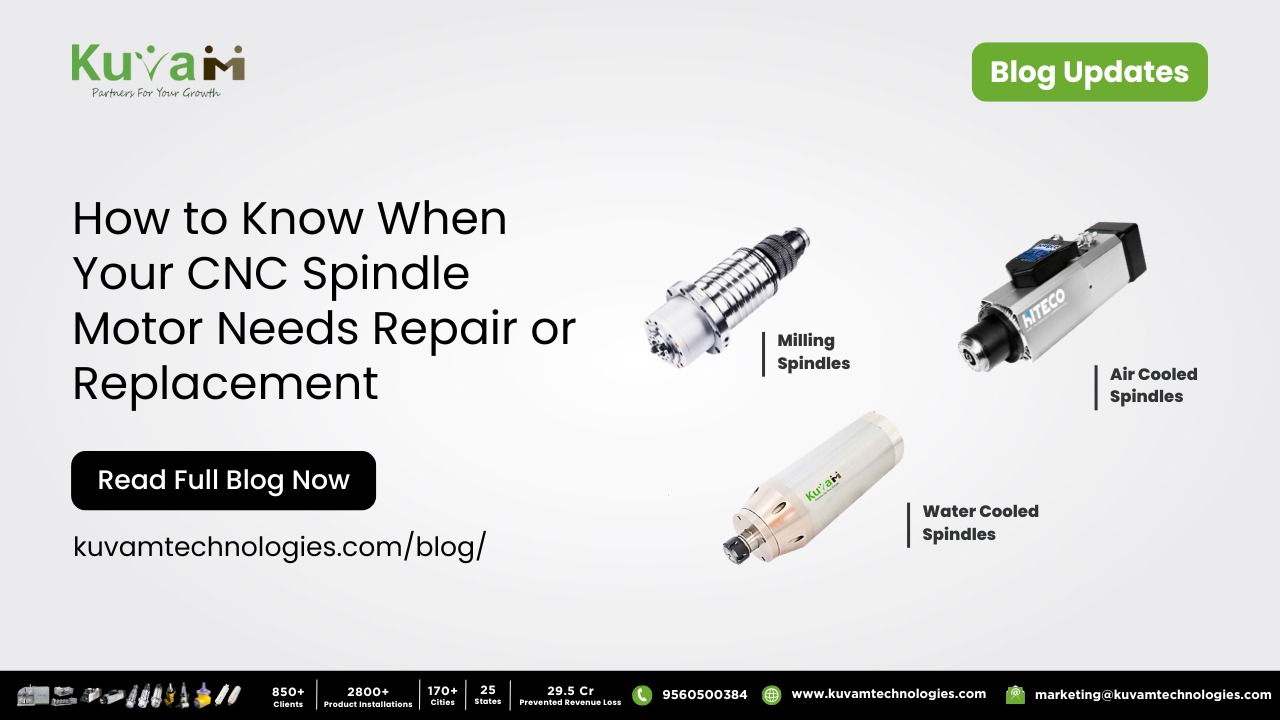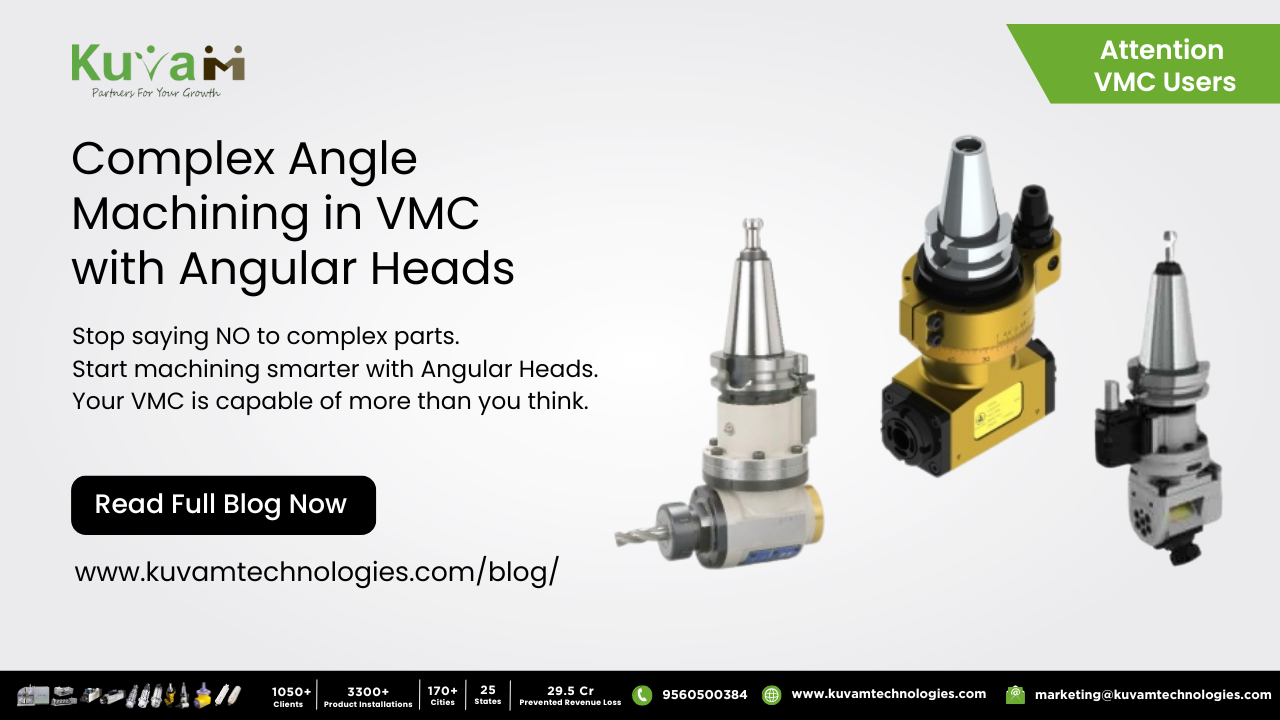In the world of CNC machining, success often depends on the reliability of every component. At the heart of this precision lies the CNC spindle motors, the driving force that keeps tools cutting, milling, and shaping with accuracy.
While designed for performance, even the finest spindles have defined life cycles. Over time, natural wear and tear can lead to reduced efficiency, compromised quality, unplanned downtime, or in critical cases, complete motor failure. Each of these not only disrupts production but also impacts profitability.
In this blog post, we’ll break down the clear signs that your CNC spindle motors might be on its last legs and in need of repair or a full replacement. We’ll chat about various types, including air-cooled ATC and MTC setups, belt-driven spindle motors, direct-driven spindle motors, turning spindle motors, and built-in spindle motors. As folks at Kuvam Technologies, we’ve fixed and upgraded countless of these, so trust me, spotting issues early can save you a ton of hassle. Let’s dive in and keep your shop running like a well-oiled machine!
Why Your CNC Spindle Motors Matter More Than You Think
Picture this: you’re midway through a big project, and suddenly, your CNC machine starts acting up. The culprit? Often, it’s the CNC spindle motors. This component is responsible for rotating your tools or workpieces at blistering speeds while maintaining accuracy down to the micron. Whether you’re crafting aerospace parts or custom furniture, a faltering motor can ruin everything.
At Kuvam Technologies, we see this all the time. Our team designs and services spindle motors for all sorts of applications, helping businesses minimize interruptions. But prevention starts with knowledge. Ignoring subtle hints from your motor is like ignoring a check engine light—it’s going to cost you eventually. So, let’s explore the basics and then get into the warning signs.
CNC Spindle Motors Types
Not all CNC spindle motors are created equal. Each type has its strengths, ideal uses, and potential weak spots. Knowing yours helps you diagnose problems faster. Here’s a rundown:
Air-Cooled ATC and MTC Spindle Motors
These models are a fan-favourite because they are inexpensive and simple to operate. Combined with the fact air-cooled ATC (Automatic Tool Changer) and MTC (Manual Tool Changer) models depend on air flow for cooling, these models are great for the average worker. Just be aware that if any dust detritus builds up, air-cooled machines can overheat, making it stressful for all internals.
Belt-Driven Spindle Motors
Old-school but reliable, belt-driven spindle motors use belts to connect the motor to the spindle, allowing for easy speed tweaks. They’re common in versatile setups, but belts can wear out, leading to slippage and vibrations that affect your cuts.
Direct-Driven Spindle Motors
For top-tier precision, direct-driven spindle motors skip the belts and link straight to the spindle. This means less backlash and smoother operation, perfect for high-speed tasks. However, they’re sensitive to bearing issues, which can throw off your entire alignment.
Turning Spindle Motors
If you’re into lathes, turning spindle motors are your go-to. They focus on high torque at lower speeds to spin workpieces evenly. Overloading them with tough materials? That’s a recipe for wobble and heat problems.
Built-In Spindle Motors
Compact and powerful, built-in spindle motors embed the motor right into the spindle housing. They’re efficient for space-tight machines and high-RPM work, but repairs can be tricky since everything’s integrated—think specialized tools required.
No matter if you’re dealing with an air-cooled ATC and MTC or a belt-driven spindle motor, regular checks are key. At Kuvam Technologies, we tailor solutions for each type, ensuring you get the best fit for your needs.
Signs of Trouble in Your CNC Spindle Motors
Alright, let’s get to the juicy part. These signs aren’t always screaming at you, but they’re there if you pay attention. Catching them early? That’s how you avoid a full-blown crisis. We’ll cover the most common ones with tips on what to do.
Noises That Shouldn’t Be There
Your CNC spindle motors should hum smoothly, not sound like a horror movie soundtrack. Unusual noises are often the first clue that something’s off.
- Grinding or Growling Sounds: This screams bearing wear, especially in direct-driven spindle motors where every part needs to be spot-on.
- Whining or Squealing: Could be dry lubrication in turning spindle motors—time to grease up!
- Rattling or Clicking: Loose parts in built-in spindle motors? Don’t ignore it; it could lead to bigger damage.
Pro tip: Record the noise and compare it to online demos. If it’s persistent, shut down and inspect. We’ve had clients at Kuvam Technologies fix this with a simple bearing swap, saving thousands.
Shaking and Vibrations Taking Over
A little vibe is normal, but if your machine feels like it’s dancing the cha-cha, Houston, we have a problem. Excessive vibration points to imbalance or wear in your CNC spindle motors.
- In air-cooled ATC and MTC systems, poor cooling can cause thermal shifts leading to shakes.
- Belt-driven spindle motors often vibrate from stretched or misaligned belts.
- Direct-driven spindle motors might wobble due to spindle runout.
Grab a vibration analyzer tool—it’s inexpensive and reveals a lot. Unchecked vibrations not only mess with part quality but can crack frames over time.
When Things Get Too Hot to Handle
Heat buildup is a silent killer for any CNC spindle motors. If it’s running hotter than your morning coffee, investigate pronto.
- Air-cooled ATC and MTC motors overheat from clogged fans or poor airflow.
- Turning spindle motors might fry under heavy loads without proper ventilation.
- Built-in spindle motors can suffer if integrated coolants fail.
Use an infrared thermometer to monitor. Chronic overheating warps rotors and stators, slashing efficiency. At Kuvam Technologies, we recommend upgrading cooling systems for high-demand ops.
Dropping Power and Torque Issues
Feeling like your motor’s lost its mojo? A loss in power or torque means it’s struggling to keep up, affecting cut quality and speed.
- Belt-driven spindle motors slip under load from worn belts.
- Direct-driven spindle motors lose torque from electrical faults or bearing drag.
- Turning spindle motors falter with inconsistent RPMs on dense materials.
Test with a dynamometer if possible. This sign often creeps up, so track performance logs to spot trends early.
Rough Finishes and Inaccurate Cuts
Your workpieces tell tales. If surfaces are chattery, uneven, or off-spec, blame the CNC spindle motors.
- Built-in spindle motors with play in bearings cause tool chatter.
- Air-cooled ATC and MTC setups might underperform from heat-induced expansion.
- Direct-driven spindle motors lose precision from misalignment.
Inspect tools first, but if they’re good, dive into the motor. Poor finishes waste material and time—fix it to keep clients happy.
Error Codes Popping Up Like Popcorn
Modern CNCs are smart; they flash codes when something’s wrong. Spindle-related errors? Straight to the motor.
- Overload codes in turning spindle motors signal torque limits hit.
- Speed faults in belt-driven spindle motors point to drive issues.
- Thermal alerts in air-cooled ATC and MTC? Cooling failure alert!
Document codes and cross-reference your manual. If stumped, our team at Kuvam Technologies can decode and repair.
Obvious Physical Damage
Sometimes, it’s staring you in the face. Visual checks reveal a lot about your CNC spindle motor’s health.
- Cracks or rust on housings.
- Leaks from seals in built-in spindle motors.
- Frayed belts in belt-driven spindle motors.
For air-cooled ATC and MTC, inspect fins for bends. Make this a weekly habit—prevention is cheaper than cure.
Repair or Replace: What’s the Smart Move?
Once you’ve spotted the signs, decide: fix it or ditch it? Here’s how to choose wisely.
Go for Repair If…
The problem’s isolated, like a belt swap in belt-driven spindle motors or cleaning in air-cooled ATC and MTC. Repairs are quicker and cheaper for newer motors. Kuvam Technologies offers fast turnaround with OEM parts.
Opt for Replacement When…
Damage is deep, such as fried windings in direct-driven spindle motors or cracked casings in turning spindle motors. Replacing with a modern built-in spindle motor could amp up your efficiency. Factor in age, cost, and downtime—we help clients upgrade seamlessly.
Keeping Your CNC Spindle Motors Healthy: Maintenance Must-Dos
Don’t wait for trouble. Proactive care extends life and boosts performance. Try these tips:
- Clean Regularly: Dust kills air-cooled ATC and MTC—vacuum vents often.
- Lube It Up: Stick to schedules for belt-driven spindle motors to avoid dry runs.
- Balance Tools: Essential for direct-driven spindle motors to cut vibrations.
- Monitor Heat: Sensors on turning spindle motors catch issues early.
- Annual Pro Checks: Let experts like Kuvam Technologies inspect built-in spindle motors.
- Avoid Overloads: Match jobs to motor specs for longevity.
These habits can add years to your CNC spindle motor’s life.
Act Now, Save Later
Your CNC spindle motors is the star of the show, but it needs TLC. From weird noises to hot spots, these signs scream for attention. Whether it’s a direct-driven spindle motor or a built-in one, early action prevents disasters.
At Kuvam Technologies, we’re all about empowering your operations. Spotting issues? Reach out for expert advice, repairs, or replacements. What’s the weirdest sign you’ve seen in your motor? Drop a comment – we’re here to chat and help!




